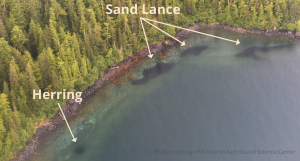
Crude oil is often referred to as a “fossil fuel” because it is made up of plants and animals that lived millions of years ago. Over time, these remains were exposed to heat and pressure inside the Earth’s crust, forming crude oil.
This process is full of variables. The organic materials that make up one pocket of oil can differ from another, or the deposit could have been exposed to different pressures or temperatures during formation. These variables mean oils have different properties such as density, viscosity (thickness), or tendency to form an emulsion.
The oil pumped through the Trans Alaska Pipeline System is a mixture from different fields. That mixture changes over time. The properties of oil can change as the field ages, and new fields are brought into production.
These variations mean the oil behaves differently. It can flow faster or slower, or evaporate more readily.
These, and other variations, influence the techniques used to clean up a spill.
Approximately every five years, the Council obtains a sample of crude oil from the Trans Alaska Pipeline System for analysis. Researchers look at properties such as weight, evaporation, and emulsification. A new report summarizes the latest findings.
Weight
A “heavy” oil is denser than a “light” oil, which flows more easily. Heavy oils are more useful for asphalt and plastics, while lighter oils are processed into gasoline and jet fuel.
When the pipeline first started transporting oil, the oil was considered “heavy.” In 2010, a sample analyzed by the Council found that the oil had lightened considerably. The trend continued in 2015 and again with this recent sample, although the shift has not been as dramatic since 2010. The most recent analysis categorizes the oil as a “medium” viscosity.
These properties may affect response tactics. For instance, if spilled, lighter oils may be easier to pump, however lighter oils could spread more rapidly, covering a larger area.
Evaporation
Lighter weight oils are made up of substances that evaporate more easily. A fuel such as gasoline can evaporate completely at temperatures above freezing. In crude oil, however, evaporation of lighter molecules leaves behind heavier components of the oil. The heavier oil components emulsify more readily.
Emulsification
Emulsification is the process by which one liquid is dispersed into another one in the form of small droplets. Mayonnaise is an example of an emulsion: oil, water, and egg yolks are whisked together to form a thick paste, with the egg serving as the emulsifier to keep the oil and water from separating. In a similar fashion, ocean waves and wind can mix water droplets into spilled oil.
Some emulsified oils break down and separate back into oil and water over time, however in heavier oils, this mixture can stabilize, becoming permanently emulsified.
Emulsified oil is much more difficult to clean up. The volume can triple in size and become almost solid. If the emulsion stabilizes, it is difficult or impossible to recover with a skimmer.
Oil samples analyzed by the Council prior to 2001 formed stable emulsions when weathered. Tests performed on the recent sample found that the newer oil will emulsify, but does not stabilize into a permanent emulsion.
Report available online
The tests on the sample were conducted by Environment and Climate Change Canada. Dr. Merv Fingas interpreted the lab results, which are summarized in the new report:

